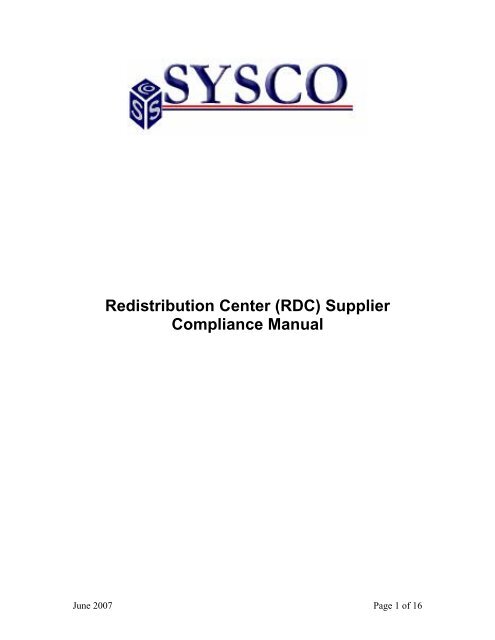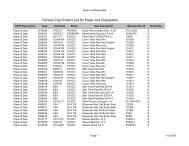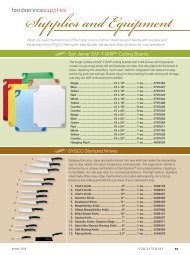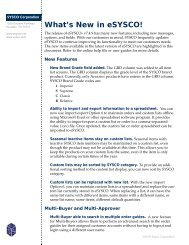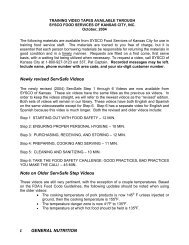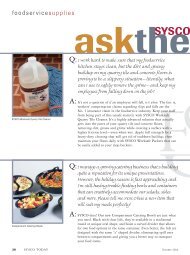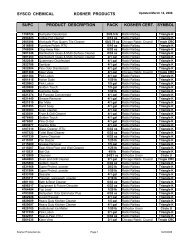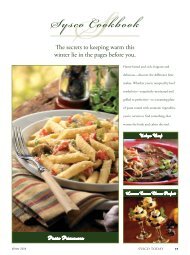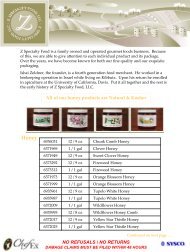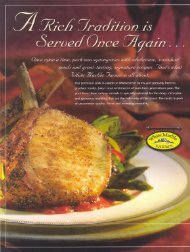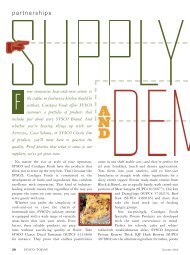Redistribution Center (RDC) Supplier Compliance Manual - Sysco
Redistribution Center (RDC) Supplier Compliance Manual - Sysco
Redistribution Center (RDC) Supplier Compliance Manual - Sysco
Create successful ePaper yourself
Turn your PDF publications into a flip-book with our unique Google optimized e-Paper software.
<strong>Redistribution</strong> <strong>Center</strong> (<strong>RDC</strong>) <strong>Supplier</strong><br />
<strong>Compliance</strong> <strong>Manual</strong><br />
June 2007 Page 1 of 16
SYSCO <strong>RDC</strong> <strong>Supplier</strong> <strong>Compliance</strong> <strong>Manual</strong><br />
TABLE OF CONTENTS<br />
PRE-REQUISITES .......................................................................................................................... 3<br />
BSCC BILLED REQUIREMENTS....................................................................................................... 3<br />
TRADITIONAL TRADING DOCUMENTS REQUIREMENTS ...................................................................... 3<br />
<strong>RDC</strong> PRICING REQUIREMENTS....................................................................................................... 3<br />
SERVICE LEVEL REQUIREMENTS .............................................................................................. 3<br />
SHIPMENT READINESS ................................................................................................................... 3<br />
PURCHASE ORDER ........................................................................................................................ 4<br />
BACKORDERS................................................................................................................................ 4<br />
PRODUCT DAYS TO PROCESSING (LEAD TIME)................................................................................ 4<br />
ORDER EXCEPTIONS...................................................................................................................... 4<br />
Return Authorization ............................................................................................................... 4<br />
Direct Shipments to SYSCO Operating Companies............................................................... 4<br />
Drop Shipments to Customers................................................................................................ 5<br />
TRANSPORTATION REQUIREMENTS......................................................................................... 5<br />
FREIGHT TERMS ............................................................................................................................ 5<br />
SHIPPER LOAD AND COUNT............................................................................................................ 5<br />
DETENTION AT SUPPLIER’S DOCK................................................................................................... 5<br />
RAIL OR INTER-MODAL SHIPMENTS ................................................................................................. 6<br />
BILL OF LADING............................................................................................................................. 6<br />
OVERAGES, SHORTS AND DAMAGES (OS&D) PROCEDURE ............................................................. 7<br />
<strong>RDC</strong> ELECTRONIC REQUIREMENTS .......................................................................................... 7<br />
ADVANCE SHIP NOTICE (ASN) (EDI 856)....................................................................................... 7<br />
ADVANCE SHIP NOTICE (ASN) (EDI 856) REQUIREMENTS .............................................................. 8<br />
OPERATIONAL REQUIREMENTS ................................................................................................ 9<br />
LOAD QUALITY .............................................................................................................................. 9<br />
PACKAGING REQUIREMENTS .......................................................................................................... 9<br />
PALLET SPECIFICATION.................................................................................................................. 9<br />
PALLET COMPOSITION ................................................................................................................. 10<br />
PALLET LABELING ..................................................................................................................... 10<br />
LICENSE PLATE NUMBER (LPN) LABELS....................................................................................... 10<br />
CASE IDENTIFICATION .................................................................................................................. 11<br />
Global Trade Item Number (GTIN) ....................................................................................... 11<br />
Catch Weight Labels.............................................................................................................11<br />
Catch Weight Labels (cont’d)................................................................................................ 12<br />
MINIMUM PRODUCT SHELF LIFE ................................................................................................... 12<br />
DATA VALIDATION REQUIREMENTS........................................................................................ 12<br />
REQUIRED DOCUMENTATION................................................................................................... 12<br />
APPENDIX A: CONTACTS .......................................................................................................... 13<br />
APPENDIX B: EAN/UCC-128 LPN LABEL ................................................................................. 14<br />
APPENDIX C: SAMPLE GTIN LABELS ...................................................................................... 15<br />
APPENDIX D: SAMPLE OF CASE LABELS............................................................................... 16<br />
June 2007 Page 2 of 16
SYSCO <strong>RDC</strong> <strong>Supplier</strong> <strong>Compliance</strong> <strong>Manual</strong><br />
Pre-Requisites<br />
There are 3 major pre-requisites for becoming an <strong>RDC</strong> <strong>Supplier</strong>. A supplier must be:<br />
1. BSCC Corporate Billed<br />
2. a Member of the iTrade Network with the ability to meet BSCC’s electronic<br />
trading requirements; and<br />
3. <strong>RDC</strong> priced<br />
BSCC Billed Requirements<br />
As a pre-requisite to becoming a <strong>RDC</strong> <strong>Supplier</strong>, the <strong>Supplier</strong> must be compliant with<br />
BSCC Corporate Billed requirements. Contact the BSCC Billing Department for more<br />
information (see Appendix A).<br />
Traditional Trading Documents Requirements<br />
As a pre-requisite, an <strong>RDC</strong> <strong>Supplier</strong> must be a signed member of the iTrade Network<br />
and have the ability to receive and send required documents electronically. iTrade<br />
Network and e<strong>Supplier</strong> Solutions will assist you in meeting BSCC’s specification<br />
requirements. All required fields must be returned on all inbound documents. An<br />
<strong>RDC</strong> <strong>Supplier</strong> must also have the ability to receive electronic purchase orders (850),<br />
create electronic acknowledgements (997), generate multiple electronic confirmations<br />
(855) and invoices electronically (810). Additional details concerning the ASN 856<br />
will be provided later in the manual. Appendix A on page 13, provides contact<br />
information of the e<strong>Supplier</strong> Solutions Specialist who will assist you with trading<br />
document requirements for the <strong>RDC</strong>.<br />
<strong>RDC</strong> Pricing Requirements<br />
As a pre-requisite, a supplier must reach agreement with SYSCO on the <strong>Supplier</strong><br />
Adoption Savings achieved going through the <strong>RDC</strong>. Contact your BSCC Category<br />
Operations Manager for more information regarding <strong>RDC</strong> Pricing (see Appendix A).<br />
Service Level Requirements<br />
The SYSCO Service Level requirement is defined as the fulfillment of a purchase order<br />
without substitutions. The following requirements are necessary to ensure that SYSCO is<br />
able to maintain its service level commitments to customers:<br />
Shipment Readiness<br />
• <strong>Supplier</strong> will be held accountable for 100% fill rate of original quantity<br />
ordered.<br />
• As is standard procedure at SYSCO Operating Companies, short shipments<br />
will incur freight charges. Short shipments must be transmitted electronically<br />
via 855 confirmations. To ensure changes can be processed through all<br />
systems, it is recommended the supplier notify the replenishment analyst<br />
June 2007 Page 3 of 16
SYSCO <strong>RDC</strong> <strong>Supplier</strong> <strong>Compliance</strong> <strong>Manual</strong><br />
through electronic communication of any occurrence of product shortage 72<br />
hours prior to pick-up date. Freight charges will be incurred if less than 48<br />
hours prior notification is given.<br />
Purchase Order<br />
• A purchase order must not be split over multiple shipments (whether by<br />
multiple truckloads, multiple railcars, multiple containers, or a combination of<br />
any).<br />
• Multiple purchase orders are acceptable on a single truckload or rail car.<br />
• The <strong>Supplier</strong> must ensure that the correct Purchase Orders are loaded on the<br />
designated truck.<br />
Backorders<br />
• Backorders and substitutions are not accepted.<br />
• A supplier must notify the Replenishment Analyst regarding fulfillment of<br />
previously backordered product.<br />
Product Days to Processing (Lead Time)<br />
• The <strong>Supplier</strong> is required to have all product ready within the agreed timeframe<br />
to process an order (the number of order process days that lapse between an<br />
order placement and pickup at the supplier's supply point) for each adopted<br />
location.<br />
• The <strong>Supplier</strong> must notify the appropriate Replenishment Analyst at least 30<br />
days prior to any changes in lead time.<br />
Order Exceptions<br />
Order exceptions refer to situations when the flow of the order is altered due to<br />
extenuating circumstances. Examples of this include, but are not limited to constrained<br />
product, return or recall of defective product, direct shipments to Operating<br />
Companies, drop shipments, etc. <strong>Supplier</strong>s must comply with the following<br />
requirements:<br />
Return Authorization<br />
• A return request must be acknowledged within 24 hours and approved by the<br />
<strong>Supplier</strong> via email.<br />
• A return request can be initiated by OPCO personnel or the Operations Claim<br />
Coordinator.<br />
• <strong>Sysco</strong> will coordinate with the <strong>Supplier</strong> the return of product. In the event the<br />
product is returned due to quality issues, it is the responsibility of the <strong>Supplier</strong><br />
to pick up the product either from the <strong>RDC</strong> or an Operating Company.<br />
Direct Shipments to SYSCO Operating Companies<br />
• Specified shipping date or shipping window must be adhered to.<br />
June 2007 Page 4 of 16
SYSCO <strong>RDC</strong> <strong>Supplier</strong> <strong>Compliance</strong> <strong>Manual</strong><br />
• Shipment will have exact quantity ordered. SYSCO will not accept<br />
backorders, overages, shortages, or substitutes.<br />
Drop Shipments to Customers<br />
• Specified shipping date or shipping window must be adhered to.<br />
• Shipment will have exact quantity ordered. No backorders, overages,<br />
shortages, or substitutes will be accepted.<br />
• Shipments of multiple purchase orders must not be consolidated in a single<br />
shipping carton.<br />
• BSCC does not maintain a DUNS number for our 415,000+ customers.<br />
Please refer to the e<strong>Supplier</strong> Solutions Guide provided by your designated<br />
ESS Contact for details regarding DUNS requirements.<br />
Transportation Requirements<br />
Freight Terms<br />
SYSCO’s freight terms for products purchased by the <strong>RDC</strong> are FOB Shipper’s<br />
Dock, Shipper Load, Count and Seal.<br />
Shipper Load and Count<br />
<strong>Supplier</strong>s are required to seal all trucks prior to the truck leaving their ship point.<br />
<strong>Supplier</strong>s are responsible for:<br />
• Loading correct case quantity<br />
• Ensuring integrity of all loaded cases<br />
• Adequate shelf life as provided by <strong>Sysco</strong><br />
• Securing the load<br />
• Sealing all shipments prior to the truck leaving the facility<br />
In the event that a truck arrives at a supplier’s facility sealed, the supplier must note<br />
and record the seal number of the seal that is being broken, and record the new seal<br />
number on the Bill of Lading.<br />
Detention at <strong>Supplier</strong>’s Dock<br />
• SYSCO expects loading time not to exceed two (2) hours.<br />
• Where feasible, for those <strong>Supplier</strong>s requiring additional loading time on a<br />
regular basis, a Drop Trailer program may be implemented. The Drop Trailer<br />
program depends upon volume requirements and will be determined during<br />
the readiness call between <strong>Sysco</strong> and the supplier.<br />
• A detention charge, identified by <strong>Supplier</strong> Ship-Point, will be assessed to<br />
<strong>Supplier</strong>s if they continually exceed a reasonable amount of loading time.<br />
June 2007 Page 5 of 16
SYSCO <strong>RDC</strong> <strong>Supplier</strong> <strong>Compliance</strong> <strong>Manual</strong><br />
• The industry standard for detention charges, after the two hour allowable<br />
loading time, is $60.00 per hour chargeable in 15 minute increments. In the<br />
event of a carrier arriving late for scheduled appointment, all detention<br />
charges will be automatically waived.<br />
Rail or Inter-modal Shipments<br />
• All railcars are to be loaded based on the published loading guidelines<br />
provided by the local railroad that services the individual shipping facility.<br />
• All railcars are to be inspected by the supplier’s shipping facility prior to<br />
loading to insure the car is clean with no holes and/or strong odors.<br />
• All refrigerated or frozen rail cars are required to have a TTR (Temperature<br />
Tracking Recorder).<br />
• The supplier is required to include a placard which indicates the side of the rail<br />
car to be used for unloading. This is usually the same side the supplier uses to<br />
load.<br />
• Once the car is loaded, a copy of the Bill of Lading (BOL) must be faxed to the<br />
<strong>RDC</strong> at (540) 631-2303.<br />
In the case of rail or inter-modal shipments from <strong>Supplier</strong>’s plants or Distribution<br />
<strong>Center</strong>s, the supplier will email a shipment notification to:<br />
IBFRTRYL@Corp.<strong>Sysco</strong>.Com<br />
Bill Of Lading<br />
Every shipment to the <strong>RDC</strong> must be accompanied by a Bill of Lading (BOL) that<br />
complies with U. S. Department of Transportation (USDOT) regulations. The<br />
following data should be referenced in the Bill of Lading:<br />
• SYSCO Purchase Order Number<br />
• <strong>Supplier</strong>’s Name<br />
• Bill To Address<br />
• Ship to Address<br />
• Customer Number – <strong>Supplier</strong>’s SYSCO Customer number<br />
• Sales Order Number – <strong>Supplier</strong>’s Sales Order number that relates to the<br />
SYSCO Purchase Order<br />
• Ship Date<br />
• Estimated Arrival Date<br />
• Bill of Lading Number<br />
• Seal Number<br />
• Product Code<br />
• Qty Shipped per Item and Total Load<br />
• Product Description<br />
• Weight per Item and Total Weight Shipped (Net Weight for Catch-Weight<br />
items)<br />
• Pallet Count<br />
• Carrier<br />
• Load Temp (maintain at)<br />
• Lot Number<br />
June 2007 Page 6 of 16
SYSCO <strong>RDC</strong> <strong>Supplier</strong> <strong>Compliance</strong> <strong>Manual</strong><br />
• Load Number – <strong>Supplier</strong>’s unique Load Number identifier<br />
• Country of Origin for Imported Products – COOL is mandatory on the BOL<br />
• Carrier Obligation Responsibility – Freight Terms (FOB Buyer’s Truck<br />
Shipper Load, Count, and Seal)<br />
Overages, Shorts and Damages (OS&D) Procedure<br />
The following description of SYSCO’s OS&D procedure provides a brief overview of<br />
the procedure and what <strong>Supplier</strong>s can expect when there is an OS&D claim.<br />
1. <strong>RDC</strong> will receive product against the purchase order.<br />
2. If OS&D is confirmed, the <strong>RDC</strong> will initiate OS&D claim. <strong>RDC</strong> Receiver will<br />
photograph and document any damages for claim processing.<br />
3. <strong>RDC</strong> Transportation will make an assessment to the cause of damage, notify<br />
the responsible party, and complete the OS&D report.<br />
4. Follow-up on OS&D will be completed by the <strong>RDC</strong>. Expectations are:<br />
• Overages – A/P or Transportation calls <strong>Supplier</strong>/Broker and informs<br />
•<br />
•<br />
<strong>RDC</strong> Electronic Requirements<br />
Advance Ship Notice (ASN) (EDI 856)<br />
The Advance Ship Notice (ASN or EDI 856) is a transaction used to confirm the<br />
configuration of a shipment of goods as well as additional information relating to<br />
the shipment. This transaction will describe the shipment at the pallet level, and<br />
will include such information as lot numbers, pack dates, expiration dates, and net<br />
weight of catch weight items. Complete and accurate ASN’s will ensure quick<br />
and efficient receipt of your products.<br />
about<br />
overage – the <strong>RDC</strong> agrees to buy or may initiate a Return Authorization.<br />
Shortage – A/P or Transportation calls <strong>Supplier</strong>/Broker for authorization<br />
to deduct or will file a claim against the carrier. In the event of an <strong>RDC</strong><br />
shortage that causes a warehouse out the supplier will expedite delivery of<br />
product at supplier’s expense.<br />
Damages – A/P or Transportation informs <strong>Supplier</strong>/Broker and Carrier of<br />
damaged product who will submit authorization for <strong>RDC</strong> to file claim<br />
along with details to destroy, dump, or return the product.<br />
• The ASN is required to be received prior to shipment’s arrival at the <strong>RDC</strong>. It<br />
is recommended that the ASN be transmitted as the load is sealed at your<br />
dock.<br />
• Various levels of LPN label configurations will be tested during<br />
implementation.<br />
• The ASN must accurately provide all required information about<br />
the incoming<br />
shipment. This information may include, but is not limited to the following<br />
ASN elements:<br />
June 2007 Page 7 of 16
SYSCO <strong>RDC</strong> <strong>Supplier</strong> <strong>Compliance</strong> <strong>Manual</strong><br />
Advance Ship Notice (ASN) (EDI 856) Requirements<br />
Requirement<br />
Description<br />
Unique Shipment<br />
Unique ASN number<br />
Identification Number<br />
SYSCO Purchase Order<br />
<strong>Sysco</strong> Purchase Order sent to the supplier. This appears at<br />
Number<br />
the header level.<br />
SYSCO Purchase Order The sequence of line items on the ASN must be the exact<br />
Number Line Item Sequence line item indicator as the Purchase Order (850).<br />
SYSCO Order Control Order control number (OC#) is a unique number assigned<br />
Number<br />
by BSCC for all orders.<br />
SYSCO Uniform Vendor<br />
The 6-digit number assigned to the <strong>Supplier</strong> by SYSCO to<br />
Code (SUVC)<br />
represent the <strong>Supplier</strong> in SYSCO’s systems.<br />
Ship-From Name<br />
<strong>Supplier</strong>’s Name.<br />
Ship-From Address <strong>Supplier</strong>’s Address.<br />
Global Location Number The GLN provides a standard means to identify trading<br />
parties and locations to support the requirements of<br />
electronic commerce. More information may be obtained<br />
by visiting the Uniform Code Council site on GLN at<br />
http://www.uccouncil.org/ean_ucc_system/pdf/GLN_0205.pdf<br />
Ship To Information The physical address where the PO’s are being shipped to.<br />
SYSCO Uniform Product The SYSCO 7-digit number corresponding to the<br />
Code (SUPC)<br />
<strong>Supplier</strong>’s item number assigned to the <strong>Supplier</strong>’s item by<br />
SYSCO.<br />
SUPC Pallet Quantity An item may span multiple pallets, but the quantity should<br />
reflect the actual quantity per LPN per pallet.<br />
Lot Number<br />
Lot# or batch# must be included on the pallet level ASN.<br />
If there are multiple lots on a pallet of product, multiple<br />
lot numbers must be provided in the ASN.<br />
Manufacture Date<br />
If the product has a Manufacture Date printed on the case<br />
or inner pack, it must be included on the ASN.<br />
Expiration Date<br />
If the product has Expiration or Use By Date printed on<br />
the case or inner pack, it must be included on the ASN.<br />
Net Weight<br />
If the product is a catch weight item (sold by the pound)<br />
the net weight of the product on the pallet must be<br />
included in the ASN.<br />
June 2007 Page 8 of 16
SYSCO <strong>RDC</strong> <strong>Supplier</strong> <strong>Compliance</strong> <strong>Manual</strong><br />
Operational Requirements<br />
Load Quality<br />
• All loads should be secured and stabilized in such a way to eliminate product<br />
damage during transit.<br />
• Stretch wrap should cover all the product and extend halfway down the physical<br />
pallet securing all product to the pallet.<br />
• Corner boards may be incorporated to eliminate crushing product when stacking<br />
pallets.<br />
• Multiple stacked pallets may be stretch wrapped together to reduce load shifting.<br />
• Glue or tape cannot be used to stabilize cases since it will interfere with SYSCO’s<br />
de-palletizing equipment.<br />
• Pallets may be pinwheeled to improve stability of the load while in transit.<br />
Packaging Requirements<br />
• Case dimensions for a single SKU must remain constant. No variable case<br />
dimensions (length, width or height) will be accepted.<br />
• Cases (lids and flaps) must be clean and properly secured.<br />
• Integrity of the case must be intact (damage rules apply).<br />
• The supplier will inform their designated Supply Chain Operations Analyst within<br />
30 days of any packaging changes affecting ti/hi or length, width, and height.<br />
Pallet Specification<br />
CHEP pallets are required. CHEP provides the quality needed to be successful, while<br />
offering value throughout the entire supply chain. Only in the event of an approved<br />
exception will the <strong>RDC</strong> accept pallets meeting the following specifications:<br />
1. 48" x 40" 100% Hardwood Grade A Pallet<br />
2. Four-way entry, flush non-reversible<br />
3. Top deck coverage - 82%, Bottom deck - 57%<br />
4. Minimum capacity 2800lbs with uniform distributed load<br />
All non-CHEP pallets must be approved by SYSCO prior to the supplier entering into<br />
redistribution and will be considered one way disposable pallets.<br />
Failure to meet these standards will result in a per pallet fee for labor and replacement<br />
pallet.<br />
Slip sheeted products will also be assessed a fee to provide a quality pallet required for<br />
distribution.<br />
June 2007 Page 9 of 16
SYSCO <strong>RDC</strong> <strong>Supplier</strong> <strong>Compliance</strong> <strong>Manual</strong><br />
Pallet Composition<br />
• All pallets will be built to agreed upon Ti / Hi specifications.<br />
• There should not be product overhang on the pallet.<br />
• Lot controlled items may have a maximum of two lot/expiration dates per pallet.<br />
• All SKUs on a Purchase Order in quantities of one tier/layer or greater must be<br />
placed on their own pallet.<br />
• Individual SKUs ordered in less than tier/layer quantity may be mixed on a pallet<br />
with other less than tier/layer SKUs. The items must have a unique LPN for each<br />
case and like items should be grouped together on the pallet.<br />
Pallet Labeling<br />
License Plate Number (LPN) Labels<br />
• All pallets will be labeled with an SSCC-18 Serial Shipping Container Code<br />
encoded in the UCC/EAN-128 symbology. This number will be scanned at<br />
receiving to match the product to data contained on the 856 – Advance Shipping<br />
Notice. Bar code must be of scannable quality to be accepted.<br />
• The data element requirements for each LPN can be found in Appendix B on Page<br />
14.<br />
• Each pallet of a single SKU will have 2 License Plates Labels. When facing the<br />
front of the pallet (40” side), the LPN will be affixed underneath the stretch wrap<br />
to the lower right hand corner of the front side and right side of the pallet as<br />
shown in the diagram below.<br />
• The ucc identification that is used for ASN transmission should be unique to each<br />
supplier. Please contact http://www.uc-council.org for information regarding<br />
your identification number.<br />
Diagram 1: LPN Location on Pallet<br />
Pallet Quantity<br />
40” Side<br />
• LPN labels should be a minimum 4” height and 6” length and yellow in color.<br />
• A sample LPN label must be provided to designated SYSCO Supply Chain<br />
Operations Analyst for approval prior to the <strong>Supplier</strong> entering redistribution.<br />
More information regarding specifications of the barcoding standard prescribe<br />
for this label may be found at http://www.uc-council.org/ean_ucc_system/pdf/SSCC.pdf<br />
• d<br />
June 2007 Page 10 of 16
SYSCO <strong>RDC</strong> <strong>Supplier</strong> <strong>Compliance</strong> <strong>Manual</strong><br />
Case Identification<br />
Global Trade Item Number (GTIN)<br />
• Each case must be bar coded on at least 2 sides with a UCC compliant 14-digit<br />
GTIN according to SYSCO’s Standard Product Identification and Bar Code<br />
Requirements.<br />
• The following two bar code symbologies are acceptable by SYSCO for encoding<br />
the SCC-14 GTIN:<br />
1. The ITF-14 (interleaved 2-of-5) bar code<br />
2. The UCC/EAN-128 ‘Fixed Content Shipping Containers’ standard<br />
(Application Identifier 01)<br />
More d etails on these standards may be found at: http://www.barcodes.gs1us.org<br />
• GTIN bar code may be on affixed labels or preprinted on the shipping container.<br />
• All bar codes must be tested for scanability and printability. Having a verification<br />
process will assure the print quality of the bar code symbol.<br />
• The supplier is responsible for testing its bar codes; either in house or the supplier<br />
can opt to contract an outside source to perform this testing.<br />
• Bar codes should attain a grade C or higher when verified.<br />
•<br />
In addition to the bar code, each label must also contain the same GTIN printed in<br />
human readable, numeric form.<br />
• All bar codes on the same package (case or unit) must be identical. For SYSCO<br />
Brand products, this must be the SYSCO assigned GTIN.<br />
• The <strong>Supplier</strong> may also choose to imprint the expiration date bar code directly on<br />
the case using the correct Application Identifier (AI) code and UCC/EAN-128<br />
symbology. This should not be a separate bar code - it should be contained in the<br />
bar code.<br />
• Catch weight product requires UCC/EAN-128 bar code symbology and the<br />
packaging indicator must be “9”. The use of the appropriate AI (application<br />
identifier) to encode the case weight is required.<br />
• See Appendix C page 15 for an example of a bar coded GTIN label with human<br />
readable code.<br />
Catch Weight Labels<br />
• All cases containing catch weight (non-fixed weight) products must have bar<br />
coded catch weight labels indicating the total weight of the product in the case<br />
affixed on at least two sides.<br />
• All catch weights must be expressed in pounds and must be rounded off to two<br />
decimal places.<br />
• The label must be bar coded according to the UCC/EAN-128 ‘U.S. – Product<br />
Measurements’ standard for net weight (Application Identifier 3202). More<br />
details on this standard may be found at – http://www.barcodes.gs1us.org.<br />
June 2007 Page 11 of 16
SYSCO <strong>RDC</strong> <strong>Supplier</strong> <strong>Compliance</strong> <strong>Manual</strong><br />
Catch Weight Labels (cont’d)<br />
• In addition to the bar code, the same catch weight must also be printed in human<br />
readable, numeric form on the label. The application identifier must precede the<br />
catch weight and must be included in parentheses.<br />
• The <strong>Supplier</strong> may also choose to imprint the expiration date bar code directly on<br />
the case.<br />
Minimum Product Shelf Life<br />
All products purchased by the <strong>RDC</strong> must have 80% or more shelf life remaining at the<br />
time of receipt at the <strong>RDC</strong>.<br />
Data Validation Requirements<br />
<strong>Supplier</strong>s must provide valid SKU and ship point data. <strong>Supplier</strong>s will be provided with a<br />
snapshot of their data from SYSCO to validate accuracy and update if incorrect. If the<br />
data is found to be invalid and the <strong>Supplier</strong> did not correct, the <strong>Supplier</strong> is liable and may<br />
be charged for the expenses incurred by <strong>Sysco</strong>.<br />
Required Documentation<br />
The following documents are required to be provided by the supplier prior to the<br />
supplier’s entry into the <strong>RDC</strong>:<br />
• Customer Pick-Up Agreement<br />
• Recall Policy<br />
• Example of Case Labels with Lot/Date Code Formatting and Breakdown (See<br />
Appendix D on Page 16)<br />
June 2007 Page 12 of 16
SYSCO <strong>RDC</strong> <strong>Supplier</strong> <strong>Compliance</strong> <strong>Manual</strong><br />
Appendix A: Contacts<br />
For questions regarding the requirements in the <strong>RDC</strong> <strong>Supplier</strong> <strong>Compliance</strong> <strong>Manual</strong>, please<br />
contact your BSCC Contact, Category Operations Manager, or Supply Chain Operations<br />
Analyst.<br />
Supply Chain Operations<br />
Phone: 281-584-6843 Fax: 281-584-5050<br />
SUPPLIERCOMPLIANCE@CORP.SYSCO.COM<br />
Coding & Standards<br />
Phone: 281-584-2838 Fax: 281-584-2710<br />
CODING&STANDARDS@CORP.SYSCO.COM<br />
e<strong>Supplier</strong> Solutions<br />
Phone: 281-584-2833 Fax: 281-584-2710<br />
SYSCO.EDI@CORP.SYSCO.COM<br />
Category Operations<br />
Phone: 281-584-5118 Fax: 281-584-5000<br />
CATOPS@CORP.SYSCO.COM<br />
BSCC Billing Admin<br />
Phone: 281-584-2339<br />
CBILL@corp.sysco.com<br />
Baugh Supply Chain Cooperative (BSCC)<br />
1390 Enclave Parkway<br />
Houston, TX 77077<br />
DUN & BRADSTREET Number: 0510996610000<br />
June 2007 Page 13 of 16
SYSCO <strong>RDC</strong> <strong>Supplier</strong> <strong>Compliance</strong> <strong>Manual</strong><br />
Appendix B: EAN/UCC-128 LPN Label<br />
A<br />
B<br />
Min Height: 1”<br />
Min. Length: 4.75”<br />
Height: 4”<br />
C<br />
D<br />
E<br />
F<br />
G<br />
H<br />
I<br />
K<br />
J<br />
LPN Data Elements<br />
Data Element Example Description<br />
Width: 6”<br />
A. Numeric<br />
Human<br />
Readable Bar<br />
Code<br />
Translation<br />
(00)100123400000005875 The application identifier (00) must precede the License Plate Number<br />
and must be included in parentheses.<br />
B. Bar Code EAN/UCC 128 symbology for LPN. 20 digits. Links to ASN.<br />
1 st 2 digits: Application identifier – always begins with 00.<br />
3 rd Extension Digit<br />
UCC Manufacturer ID<br />
Shipping Container #:Unique number for LPN. Each LPN must consist<br />
of a different SC#.<br />
Check Digit - UCC<br />
Standards (Uniform Code Council) calculates number.<br />
http://www.uc-council.org<br />
June 2007 Page 14 of 16
SYSCO <strong>RDC</strong> <strong>Supplier</strong> <strong>Compliance</strong> <strong>Manual</strong><br />
LPN Data Elements (cont’d)<br />
C. Product Description Muffin Blueberry Text description of product<br />
1.25oz<br />
D. Manufacturer ID 54217A36 <strong>Supplier</strong>’s ID to reference product<br />
E. Pack/Size 24/1.25oz Pack and Size of product<br />
F. Brand Gerties Product brand<br />
G. Ti/Hi 12-6 Vendor Pallet Ti Hi<br />
H. SUPC 1234567 SYSCO Uniform Product Code. 7 digits.<br />
I. Quantity 72 Quantity of item on pallet<br />
J. Ship Date 04-12 Date product is shipped on<br />
K. Storage Code F F=Freezer C=Cooler D=Dry<br />
Appendix C: Sample GTIN Labels<br />
Sample of UCC/EAN–128 bar code, Application identifier 01<br />
(01) 90614141000411<br />
Sample of ITF–14 bar code Placement of labels on a pallet<br />
June 2007 Page 15 of 16
SYSCO <strong>RDC</strong> <strong>Supplier</strong> <strong>Compliance</strong> <strong>Manual</strong><br />
Appendix D: Sample of Case Labels<br />
Lot and Date Explanations<br />
Lot-<br />
D0131B<br />
D = Year. In the example above the year is 2005. Every year we increase the letter<br />
by one. 2006 will be an E. Once we run out of letters, we start the alphabet over<br />
again.<br />
01= The first two numbers are the month of production in MM format.<br />
31= The third and the fourth numbers are the day of production in DD format.<br />
B= The Production Plant.<br />
Date- All of our items are coded as the pack date with a Julian Date Code format.<br />
5= The last digit of the year. In this case, it is 2005.<br />
031= The 31 st day of the year.<br />
This Julian Pack Date equals 01/31/05.<br />
June 2007 Page 16 of 16


